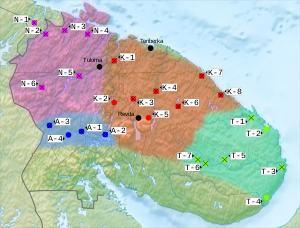Ter Sámi
| Ter Sami | |
|---|---|
| saa´mekiil / са̄мькӣлл | |
| Native to | Russia |
Native speakers | 2 (2010)[1] |
Uralic
| |
| Latin script (historical), Cyrillic script (current) [2] | |
| Language codes | |
| ISO 639-3 | sjt |
| Glottolog | ters1235 |
| ELP | Ter Saami |
 Ter Sámi is number 9 on the map. | |
Ter Sámi is the easternmost of the Sámi languages. It was traditionally spoken in the northeastern part of the Kola Peninsula, but now it is a moribund language; in 2004, only ten speakers were left. By 2010, the number of speakers had decreased to two.[1]

History

Photo taken in 2006.
In the end of the 19th century, there were six Ter Sámi villages in the eastern part of the Kola Peninsula, with a total population of approximately 450. In 2004, there were approximately 100 ethnic Ter Sámi of whom two elderly persons speak the language; the rest have shifted their language to Russian.[3]
The rapid decline in the number of speakers was caused by Soviet collectivisation, during which its use was prohibited in schools and homes[citation needed] in the 1930s, and the largest Ter Sámi village, Yokanga, was declared "perspectiveless" and its inhabitants were forced to move to the Gremikha military base.[3]
Documentation
There are no educational materials or facilities in Ter Sámi, and the language has no standardized orthography. The language is incompletely studied and documented; text specimens, audio recordings as well as dictionaries for linguistic purposes exist,[4][5] but no grammatical description is available.
The earliest known documentation of Sámi languages is a short Ter Sámi vocabulary collected by the British explorer Stephen Burrough in 1557; the vocabulary was published by Richard Hakluyt.[6]
Writing system
A spelling system for Ter Sámi using the Latin alphabet and based on Skolt Sámi was developed in the 1930s. After the Second World War, this was replaced by a system using the Cyrillic alphabet and based on Kildin Sámi.[7]
Notes
- ^ a b Sámi Languages Disappearing Barents Observer
- ^ "Ter Sámi alphabet, pronunciation and language". Omniglot.com. Retrieved 27 November 2017.
- ^ a b Tiuraniemi Olli: "Anatoli Zaharov on maapallon ainoa turjansaamea puhuva mies", Kide 6 / 2004.
- ^ Itkonen T. I.: "Koltan- ja kuolanlapin sanakirja", Helsinki: Société Finno-Ougrienne, 1958.
- ^ Itkonen T. I.: "Koltan- ja kuolanlappalaisia satuja", 1931.Memoires de la Société Finno-Ougrienne 60
- ^ Aikio Samuli: "Olbmot ovdal min - Sámiid historjá 1700-logu rádjái". Girjegiisá: Kárášjohka, 1992.
- ^ "Ter Sami alphabet, pronunciation and language". Omniglot.com. Retrieved 16 February 2018.

